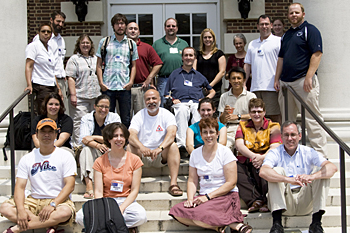Led by Ken Barner, professor in the Department of Electrical and Computer Engineering, NISE is funded through the National Science Foundation's Research Experiences for Teachers (RET) program. RET grants support the involvement of K-12 teachers and community college faculty in engineering research.
According to Kathy Werrell, assistant dean and director of engineering outreach, the program is aimed at fostering technological innovation in the classroom, facilitating the establishment of long-term collaborative partnerships, and providing teachers with an intellectually invigorating experience.
The 14 teachers participating in the first year of the NISE program range from students who are just completing degrees in math and science education to individuals with more than two decades in the classroom.
“This is a great experience for me because I'm getting the chance to interact with a lot of experienced teachers,” says Julia Somers, a senior in UD's math education program. “All of the teachers here are really passionate about what they do and excited about being innovative in the classroom.”
The theme underlying all of the projects is the use of principles from nature to enhance engineering. First-year projects are addressing materials for natural energy capture, natural fiber composites, environmental engineering and nature-inspired drug delivery, while projects in the second year will focus on bio-imaging, sensors for disease management, biomimetic flying robots and biomedical tissue engineering. The third-year program will focus on the four areas that were deemed the most successful in the first two years.
Nancy duBell, a math teacher at Aberdeen High School in Maryland, has 24 years of experience in the classroom but says she realizes there is much to gain from the RET program. One of her goals is to identify some currently relevant real-world-problem materials to use with her upper-level students.
“I also want to network with colleagues to form a community of like-minded teachers in order to share ideas and resources,” she says, “and to build a real connection with some UD engineering faculty and students with whom I can communicate and to whom I can refer my students.”
While duBell's personal goals closely mirror those of the RET program and the other teacher participants, there are intangible benefits, as well. Six days into the program, Megan Bone, a science teacher from William Penn High School in New Castle, Del., wrote in her NISE blog, “Returning to the role of the student...forces me to change my perspective and reflect on my own teaching and how it comes across to my students.”
Barner emphasizes the importance of the online tools that are being used to support the program, including a wiki platform and video conferencing. “These tools will enable us to continue interactions among the faculty and teachers during the school year and will also facilitate international collaborations,” he says. “Our goal is for the benefits and the relationships to go far beyond the six-week summer program.”
For Nick Cottone, another science teacher at William Penn, the technology is part of the lesson. In addition to content-based goals, Cottone hopes to improve technological communications with his students using a variety of sources, such as text messaging, MySpace and e-mail.
Six faculty, with support from graduate students and lab staff, are running projects this summer: Ismat Shah (materials science and engineering), Suresh Advani (mechanical engineering), Millicent Sullivan (chemical engineering), and Pei Chiu, C.P. Huang, and Paul Imhoff (civil and environmental engineering). In addition, two teachers funded on a separate NSF grant are working with Annette Shine (chemical engineering) and participating in RET activities.
“This program meshes perfectly with the milestones identified as part of UD's recent strategic planning initiative,” Michael Chajes, dean of the College of Engineering, says. “In particular, the goal to 'strengthen public education in Delaware and beyond' as part of 'The Engaged University' milestone. In addition, individual projects within the program are addressing issues associated with other strategic milestones--for example, our energy, materials, and environmental engineering projects are congruent with 'The Initiative for the Planet.'”
As for Hildebran, by day four of the program, he had already gained some insight into the perennial “Why do we need to know this?” question. “In our first day in the lab,” he says, “we had to calibrate some equipment, a process that requires a high degree of precision. I struggle with getting that concept across to my students. They see a number like 17.168, and they think it's the same as 17. Being in the lab at UD is giving me a real-world experience that I can use to show them why there is a big difference between 17 and 17.168 if you want to get accurate results from an experiment.”
Article by Diane Kukich


